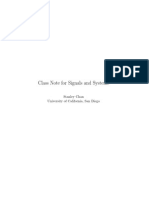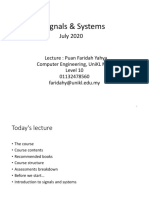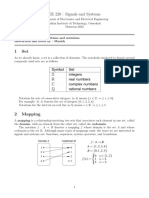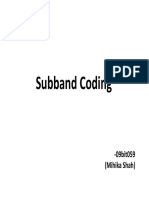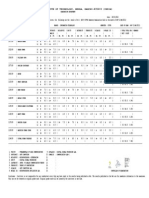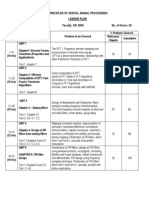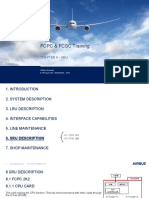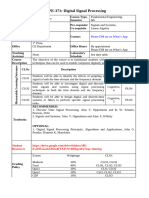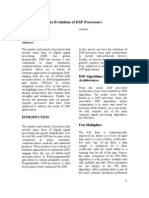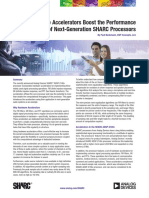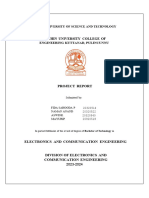EEE5109 Digital Filters
Lecture 1
1 Summary
This lecture will focus on:
1. Introduction to discrete time signals
2. Basic discrete time signals
3. Introduction to discrete time systems
4. System properties
2 Introduction to discrete time signals
Digital signal processing techniques play an important role in most modern electronic systems.
For example sophisticated signal processing algorithms allow us to hear a caller on the other end
of a telephone line even in noisy environments and are used in speech and speaker recognition
systems. Signal processing algorithms are also employed in modern wireless comunication systems.
Signal processing involves the manipulation of digital signals to achieve desired outcomes.
For example we may wish to reduce the amount of audible noise in a digital recording. Signal
processing techiques are also useful in extracting information from signals. For example speech
signals contain information about both what the speaker is saying and the identity of the speaker.
Using an appropriate transform of the speech signal, we can determine what the speaker is saying
(speech recognition) and who the speaker is (speaker recognition).
2.1 Signals
Signals are the information bearing quantities that enable the transfer of information. Mathemat-
ically we define a signal as an information bearing function of one or more variables. For example
a speech signal is a one dimensional function of time that conveys information. An image is a two
dimensional function of position. The pixel value at a given position represented by its x and y
coordinates carrys the information. Figure 1 shows a speech signal viewed in both time (bottom
panel) and frequency domain. We will learn more about frequency domain representations in this
course.
1
� 2000
Frequency 1500
1000
500
0
0.5 Time
Amplitude
−0.5
0 0.2 0.4 0.6 0.8 1
Figure 1: A speech signal viewed in both time (bottom panel) and frequency domain.
2.2 Signal classification
Signals can be classified based on different criteria. For our purposes, the most important classi-
fications are
1. Continuous time and discrete time signals: A Continuous time signal x(t) is defined for all
time t. For example body and ambient temperature are continuous time signals. Discrete
time signals are defined at discrete times only indexed by the intergers. Thus a discrete time
signal is a sequence of numbers where the nth number is denoted by x[n]. These signals
often arise from the sampling of a continuous time signal x(t) at regular intervals. Therefore
x[n] = x(nTs )
Ts is known as the sampling period. The sampling frequency is T1s . Figure 2 shows a con-
tinuous time signal (a) and the discrete time signal obtained from sampling the continuous
signal at regular intervals. Two different time domain signal can result in the same discrete
time signal after sampling. This means that an appropriate sampling rate must be chosen
to allow reconstruction of signals. We will explore this further in the course.
2. Deterministic and random signals: A deterministic signal is completely specified as a func-
tion of time. Random signals can be viewed as being drawn from a group of signals. The
particular signal drawn is subject to chance. Many real world signals have an element of
uncertainty and are best modeled as random. Figure 3 illustrates the ideas of drawing a
random signal from a group.
3. Periodic and non-periodic signals: A signal x(t) is said to be periodic if there exists a number
T such that
x(t) = x(t + T ).
2
� 1.0 1.0
0.8 0.8
0.6 0.6
0.4 0.4
0.2 0.2
0.0 0.0
0.2 0.2
0.4 0.4
0.6 0.6
0.80 2 4 6 8 10 12 14 0.80 2 4 6 8 10 12 14
(a) (b)
Figure 2: Continuous time signal (a) and the discrete time signal obtained from sampling the
continuous signal at regular intervals.
30 2 4 6 8 10 12 14
Figure 3: A group of signals (dashed lines) from which a random signal (solid line) is drawn .
The smallest value T for which this relation holds is known as the fundamental period. A
discrete time signal x[n] is periodic if there is a positive integer N such that
x[n] = x[n + N ]
Example x[n] = cos(πn/4) has a period of N = 8. Non-periodic or aperiodic signals are not
periodic.
3
�2.3 Basic Sequences
The following basic discrete time signals are important in the study of discrete time signals and
systems.
1. The unit sample sequence is defined as
�
0 n 6= 0
δ[n] =
1 n=0
This signal plays a very important role in signal processing. Any discrete signal can be
expressed in terms of the unit sample. We have
k=∞
X
x[n] = x[k]δ[n − k]
k=−∞
2. The unit step is defined as �
1 n≥0
u[n] =
0 n<0
3. The unit ramp is defined as �
n n≥0
r[n] =
0 n<0
4. Exponential sequences have the general form
x[n] = Aαn
where A and α are complex in general.
5. Sinusoidal sequences take the form
x[n] = A cos(ω0 n + φ) ∀n
where A and φ are real constants.
3 Discrete-time systems
A discrete time system transforms an input sequence x[n] into an output sequence y[n]. Math-
ematically the system is represented by a formula for computing the output sequence from the
input sequence. Some examples include
• The delay system y[n] = x[n − nd ] where nd is a positive integer
• The moving average system defined by the following equation
M2
1 X
y[n] = x[n − k]
M1 + M 2 + 1
k=−M1
The nth output sample is the average of the M1 + M2 + 1 samples around it. This serves
to smooth out abrupt changes.
4
�3.1 Linear systems
Linear systems satisfy two properties namely
1. Superposition: if the input sequence x1 [n] produces the output sequence y1 [n] and input
x2 [n] produces output y2 [n]. Then the output of the system in response to input x1 [n]+x2 [n]
is y1 [n] + y2 [n].
2. Homogeneity: If input x[n] produces output y[n], then input ax[n] where a ∈ C produces
output ay[n].
We can say that the input a1 x1 [n] + a2 x2 [n] produces the output a1 y1 [n] + a2 y2 [n]. In general we
can write that the input X
x[n] = ak xk [n]
k
produces the output X
y[n] = ak yk [n]
k
where yk [n] is the response to xk [n].
3.2 Time invariant systems
A system is said to be time invariant if a delay in the input sequence produces the same delay in
the output sequence. Also, the properties of the system do not change with time and therefore
the response does not depend on when the input is applied. Formally, if the response to x[n] is
y[n], then the response to x[n − n0 ] is y[n − n0 ].
3.3 Other system properties
1. Stability: A system is said to be bounded input bounded output (BIBO) stable if every
bounded input produces a bounded output. For a system to be of engineering use it must
be stable. Stability is explored in detail in most control systems courses.
2. Causality: A system is causal if the present output depends only on present and past inputs.
Non-causal systems can be implemented in software for example some filters require future
values to obtain estimates of present values. These systems do not operate in real time.
5
�Homework 1
1. Read the following sections of Chapter 1 of the course text, Simon Haykin and Barry Van
Veen, Signals and Systems, 2nd edition, John Wiley and Sons: 1.1, 1.2, 1.3, 1.4, 1.5 and 1.6
paying special attention to the sections on discrete time signals.
2. Using Matlab or Python, produce a stem plot the function
πn
x[n] = cos( ).
4
and verify that x[n] is periodic with period N = 8.
3. A discrete time signal x[n] is obtained by sampling the signal x(t) = sin(2πt) with a sampling
period Ts = 14 . What are the values of x[n] for −3 ≤ n ≤ 3. Can you came up with a general
formula for x[n]? Using Matlab or Python plot x(t) and superimpose a stem plot of x[n] on
the same figure.
4. For the delay system y[n] = x[n − nd ] where nd is a positive integer. Sketch the output of
the system when nd = 5 and x[n] = u[n], the unit step.











